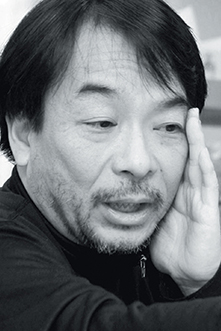- Date
- May 22, 2017
masaki fujihata
Japan
Masaki Fujihata was born in Tokyo in 1956. He is a media artist and professor at the Tokyo University of the Arts. Fujihata got his start in the 1980s working in the field of computer graphics and animation. Subsequently, along with the dramatic developments achieved in digital technologies, he began to pursue his possibilities in artistic expression, boldly moving into uncharted territory in the art world.- Date
- May 22, 2017
Joanna Zylinska
United Kingdom
www.joannazylinska.net
Joanna Zylinska is a writer, speaker, artist, and curator. She is Professor of New Media and Communications at Goldsmiths, University of London. She is the author of six books, including Nonhuman Photography (MIT Press, 2017, forthcoming), Minimal Ethics for the Anthropocene (Open Humanities Press, 2014, freely available electronic version), and Life after New Media: Mediation as a Vital Process Kember; MIT Press, 2012) - is also a translator of Stanislaw Lem's philosophical treatise, Summa Technologiae (Minnesota UP, 2013).- Date
- May 22, 2017
Annick Bureaud
France
www.annickbureaud.net
Annick Bureaud is an independent art critic, curator and event organizer, researcher and teacher of art and technoscience. She is the director of Leonardo / Olats (www.olats.org), the European sister organization of Leonardo / Isast (www.leonardo.info). She is a co-founding member of the Collectif Nunc. He wrote numerous articles and contributed to the French contemporary art magazine Art Press. She is co-editor of the essay collection Connexions: art, réseaux, media (Ensba Press, 2002) and author of Les Basiques: l'art «multimédia», an introductory book on new media art (Leonardo / Olats, 2004). ).- Date
- May 22, 2017
Sound Nuits: Polar Inertia
France
Guest year Colombia-France 2017
residentadvisor.net/dj/polarinertia
Polar Inertia is not a musical project like the others. It is a versatile and mysterious group of artists born in the underground techno scene. A polymorphic experience enlivened by different musical artists driven by the evident desire to take risks by going beyond the standards of techno and clubbing.- Date
- May 22, 2017
Hicham Berrada
France
Guest year Colombia-France 2017
With the support of Banco de la República
www.hichanberrada.com/
Hicham Berrada, born in 1986 in Casablanca (Morocco), is a Franco-Moroccan artist specializing in contemporary art and installations. Creator of constantly evolving chemical works, his process is similar to that of a painter. Its exhibitions bring together art and scientific research. In 2003 he began scientific studies in Casablanca, in 2006 he entered the School of Fine Arts in Paris and in 2011, he joined Le Fresnoy (National Studio of Contemporary Arts). Hicham Berrada creates forms in constant evolution, relevant to Art in Progress, using chemical products, such as silicates, carbonates and sulphates, which react and precipitate inside glass vats (a type of beaker) in a few liters of solution "made in house”, or in a bucket of five thousand liters of water (Arche work, 2013). These forms in movement depend on the experimental conditions (nature and concentrations of reagents, temperature, etc.).- Date
- May 22, 2017
Mathias Isouard
France
Guest year Colombia-France 2017
misouard.free.fr/
Born in 1987, Mathias Isouard graduated from the Aix-en-Provence Higher School of Art in 2011. He is one of those interdisciplinary artists who experience a sensory approach to material through empirical practices related to his sensations. Mathias Isouard's installations, which combine sculpture, image and sound in their links to space, use the acoustic qualities of a particular place or material. Matias Isouard explores and develops his own creative tools, production instruments, which sometimes become autonomous or interactive. Through "real time" treatment and productions often carried out "in-situ", the transformations of space and situations that the artist implements allow visitors to be spectators, actors, and/or objects of the scene at the same time. experience. In recent years, his work has been presented at contemporary art events such as Le domaine des mumures #2, Futur en Seine, LAB30 Media Art Festival, City Sonic, Reevox, Biennale des Jeunes Créateurs d'Europe et de la Méditerranée, World Event Young Artists, Disorder, Gamerz Festival…- Date
- May 22, 2017
Michel Wieviorka
France
Michel Wieviorka, Doctor of Letters and Human Sciences, Director of Studies at the Ecole des Hautes Études en Sciences Sociales, is the President of the Executive Council of the Foundation of the Chair of Human Sciences. He was director of the Center d'analyse et d'intervention sociologique (CADIS, EHESS-CNRS) between 1993 and 2009. From 2006 to 2010 he was President of the International Association of Sociology AIS / ISA and since 2014 he is a member of the Conseil scientifique de l'ERC (European Research Council). He was co-director with Georges Balandier of the journal Cahiers Internationaux de Sociologie from 1991 to 2011, and now directs the new journal SOCIO with Laetitia Atlani-Duault, which he created in 2013.- Date
- May 22, 2017
BuildingToBirdsLCD10kfps.cine
Billy Sims / USA
A single image serves as the onset for potentially continuous chain of phantasmagoric imagery. Using Google's image recognition in the search-by-image feature, the video moves through over 50,000 images from throughout the internet, crossing boundaries of professional and sociocultural utility. In reconciling these different modes of use, the search engine must swim across disciplines of visualization, evincing a semiotic coherence to parlay with that with the user. This transformation of content is depicted twofold. Firstly, in one view, a hyperactive slew images progresses over 31 minutes, exposing unexpected topological shifts in rapidly near-anonymous content. Secondly, at an alternatively precise scale, the first 2.6 seconds of the video is scrutinized with a high-speed-camera while being played on an LCD screen. The brief moment is magnified over 14 minutes and 36 seconds. At this speed the transition between images becomes apparently processual, and the association of content all the more conspicuous.
Prev page
123456789101112131415161718192021222324252627282930313233343536373839404142434445464748495051525354555657585960616263646566676869707172737475767778798081828384858687888990919293949596979899100101102103104105106107108109110111112113114115116117118119120121122123124125126127128129130131132133134135136137138139140141142143144145146147148149150151152153154155156157158159160161162163164165166167168169170171172173174175176177178179180181182183184185186187188189190191192193194195196197198199200201202203204205206207208209210211212213214215216217218219220221222223224225226227228229230231232233234235236237238239240241242243244245246247248249250251252253254255256257258259260261262263264265266267268269270271272273274275276277278279280281282283284285286287288289290291292293294295296297298299300301302303304305306307308309310311312313314315316317318319320321322323324325326327328329330331332333334335336337338339340341342343344345
Next page





